Why Fresh Ground White Pepper Changes Everything
How to grind white peppercorn properly can transform your cooking from bland to brilliant in seconds. Here's the quick answer:
Essential Steps:
- Toast peppercorns in a dry pan for 3-5 minutes until fragrant
- Cool completely before grinding
- Grind using a pepper mill, spice grinder, or mortar & pestle
- Sift through fine mesh to remove gritty bits
- Store in airtight container for up to 3 months
The difference between pre-ground and freshly ground white pepper is dramatic. As one passionate cook finded, "Once you try your own freshly ground pepper, you won't go back to store-bought versions."
Pre-ground pepper loses its essential oils and aromatic punch within months. Fresh grinding releases those oils right when you need them - giving you that sharp, herbaceous aroma and complex heat that makes dishes sing.
White pepper brings pure heat without the black specks, making it perfect for light-colored sauces, soups, and delicate dishes where appearance matters. But only if you grind it right.
I'm Joseph Rosenblatt PM, and I've spent years developing spice blends and helping home cooks master how to grind white peppercorn for maximum flavor impact. Through my spice brand and consulting work, I've learned that proper grinding technique is the secret to open uping white pepper's full potential.
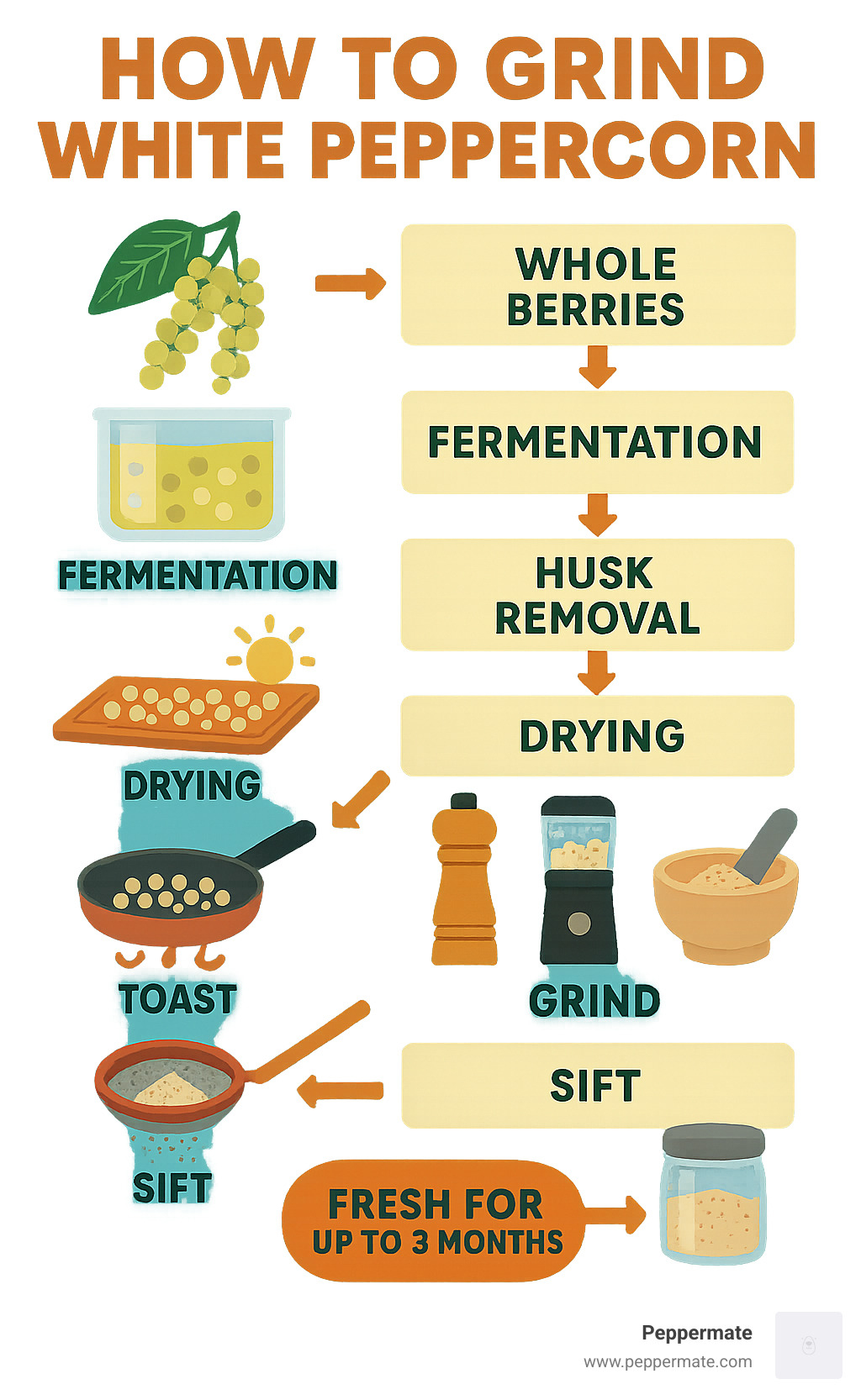
What Makes White Pepper Different?
Here's something that surprises most home cooks: white and black peppercorns are actually the same spice. They both come from the Piper nigrum plant, but their completely different processing creates flavors that couldn't be more opposite.
The magic happens after harvest. While black pepper gets dried immediately with its outer husk intact, white pepper takes a longer journey. The ripe peppercorns get soaked in water for about a week - long enough for the outer skin to soften and start decomposing. Workers then rub off these softened husks by hand, revealing the pale seed inside. After sun-drying, you get those ivory-colored peppercorns that look nothing like their black cousins.
This fermentation process strips away all the complex flavor compounds that live in black pepper's outer husk. What's left is pure, clean heat - sharp spiciness without the piney or floral notes you'd expect from pepper. Some people describe premium white pepper as having a "barnyard funk" or earthy aroma, especially varieties from traditional fermentation regions.
Different regions produce white pepper with distinct personalities, just like wine grapes. Sarawak peppercorns from Malaysia are considered the gold standard - balanced heat with subtle complexity. Muntok varieties from Indonesia deliver clean, intense heat that's perfect for Chinese cooking. Penja peppercorns from Cameroon offer a more refined profile with citrus hints, while Hainan Island varieties showcase traditional fermentation methods that create the most pronounced funky aroma.
Flavor & Aroma Snapshot
When you're learning how to grind white peppercorn, understanding its flavor profile helps you use it right. White pepper's personality is all about pure heat and fermented funk - a completely different experience from black pepper's complex bouquet.
That distinctive "barnyard" aroma comes from the fermentation process. It might smell unusual at first, but it adds incredible depth to dishes. The flavor delivers clean, sharp heat without muddying delicate flavors, plus subtle citrus notes from its botanical family origins.
This makes white pepper perfect for color-sensitive dishes where you want spice without black specks. Think cream soups, white sauces, mashed potatoes, and delicate fish preparations where appearance matters as much as taste.
Regional Varieties at a Glance
Quality and origin make a huge difference in white pepper. Single-origin terroir affects flavor just like it does with coffee or wine, and understanding these differences helps you choose the right pepper for your cooking style.
Sarawak peppercorns from Malaysia offer the most balanced profile - heat with complexity, hand-sorted twice to remove inferior seeds. Muntok varieties from Indonesia provide the clean, intense heat that Chinese cuisine demands. Penja peppercorns from Cameroon bring a refined, less funky profile with citrus hints that works beautifully in European dishes. Hainan Island varieties showcase traditional fermentation methods that create the most pronounced earthy aroma.
When sourcing white pepper, look for whole, uniform peppercorns from reputable spice vendors rather than generic supermarket versions. Quality grades matter enormously - premium varieties undergo careful sorting to remove black seeds and broken pieces that create gritty textures when ground.
Gear Up & Prep Work
Getting your equipment right makes all the difference when learning how to grind white peppercorn effectively. You don't need expensive gadgets, but having the right tools for your cooking style ensures consistent results every time.
Essential Equipment Checklist:
- Pepper mill with adjustable ceramic burr mechanism
- Electric spice or coffee grinder (dedicated to spices)
- Mortar and pestle for small batches
- Fine-mesh sieve for removing grit
- Airtight glass containers for storage
- Heavy-bottomed pan for toasting
We recommend using a dedicated grinder for spices to avoid cross-contamination. As one cook learned the hard way, "Your coffee maker will taste like steak au poivre if you use your coffee grinder for peppercorns." The lingering oils from pepper can affect your morning brew for weeks.
For cleaning your grinder between uses, try the rice hack: run a handful of uncooked rice through the grinder, brush out the resulting rice flour, wipe with a slightly damp cloth, then air-dry completely. This removes residual spice oils without water damage.
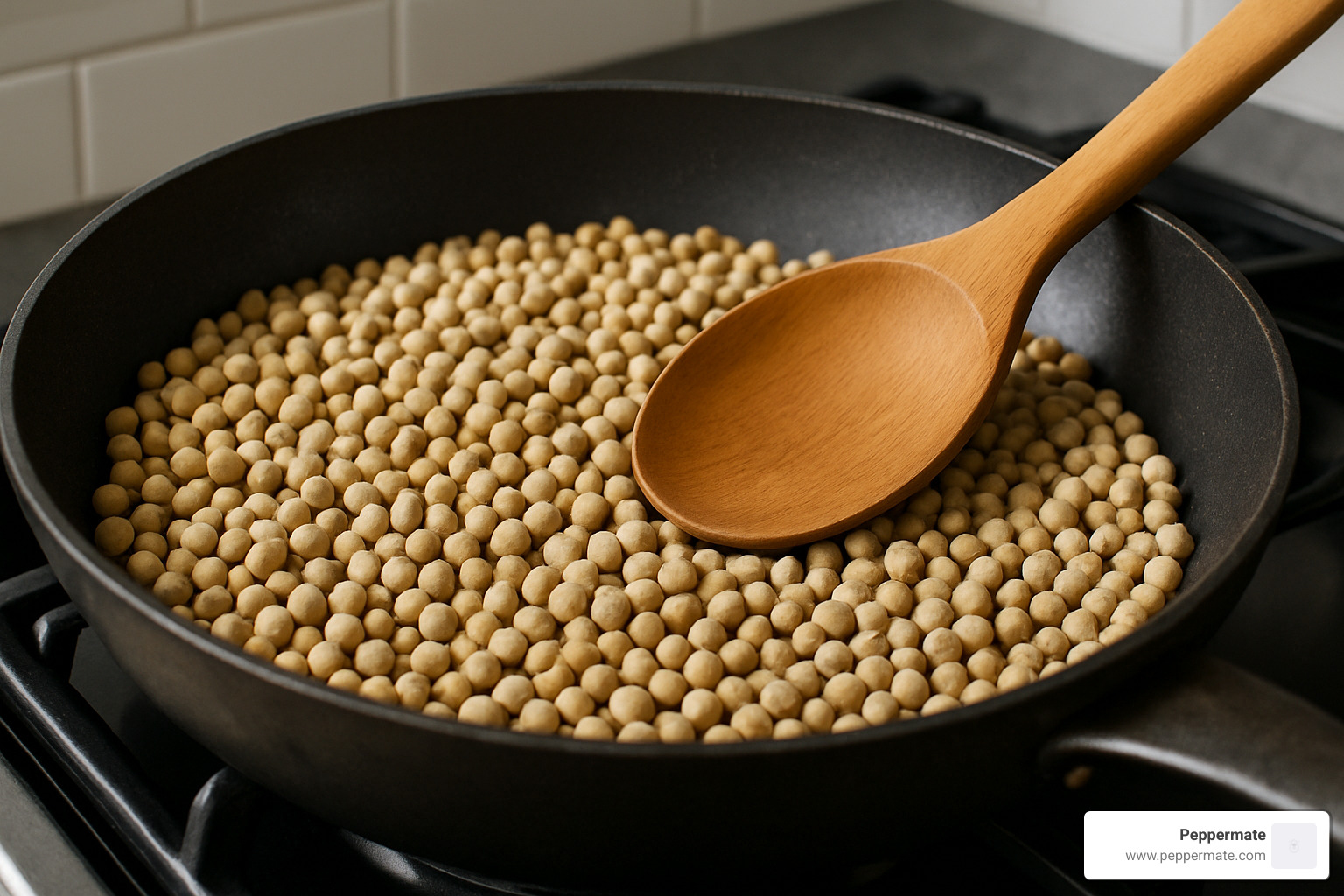
Should You Toast First?
Toasting white peppercorns before grinding is optional but highly recommended. This step intensifies their aroma and makes them more brittle for easier grinding. Here's how to do it right:
Heat a dry, heavy-bottomed pan over low heat. Add your peppercorns and stir constantly for 3-5 minutes until they become aromatic and slightly oily-looking. You'll hear a subtle crackling sound when they're ready.
The key is low heat and constant movement. Too much heat creates bitter, burned flavors that ruin the pepper's clean heat profile. Stop as soon as the peppercorns start to smell fragrant and look slightly shiny.
Test for doneness by pressing a cooled peppercorn between your fingers - it should snap cleanly with a crisp crack. If it feels spongy or bends, toast a bit longer.
Always cool toasted peppercorns completely before grinding. Hot peppercorns can create steam in your grinder, leading to clumping and uneven texture.
How to Grind White Peppercorn - Core Methods
Now we get to the fun part - turning those whole white peppercorns into aromatic powder that'll make your dishes sing. Each grinding method has its own personality, and choosing the right one depends on how much pepper you need and what texture you're after.
Think of it like choosing the right tool for any job. You wouldn't use a sledgehammer to hang a picture, and you wouldn't use a pepper mill to grind spices for a whole restaurant. Here's how to grind white peppercorn using four different approaches, each with its own sweet spot.
Your grinding toolkit: pepper mills work beautifully for small batches with precise control, electric spice grinders handle bulk prep like champions, mortar and pestle gives you that satisfying hands-on approach, and blenders tackle serious quantities when you're cooking for a crowd.
Method 1: Classic Pepper Mill - how to grind white peppercorn
A quality pepper mill is like having a reliable friend in the kitchen - always there when you need it, never lets you down. The ceramic burr mechanism gives you incredible control over grind size while keeping those precious essential oils intact.
Getting the perfect grind starts with filling your mill with those cooled, toasted peppercorns. Adjust your grind setting by turning clockwise for finer powder or counter-clockwise for coarser pieces. Hold the mill straight up and give it a good twist - that satisfying grinding sound means you're doing it right.
The real magic happens in the adjustability. You can dial in everything from fine powder that disappears into cream soups to coarse cracks that add texture to marinades. Our ceramic mills offer about 75 different grind settings, which sounds like overkill until you start experimenting with different textures.
Here's a pro tip: for the finest powder, turn the adjuster fully clockwise, grind 10-15 times, then back off 2-3 clicks and continue. This creates incredibly fine powder perfect for delicate white sauces where you want heat without any gritty texture.
Why Choose a Ceramic Pepper Mill explains why ceramic burrs stay sharp longer than steel and won't rust, giving you consistent performance for years.
Method 2: Electric Spice/Coffee Grinder - how to grind white peppercorn
Electric grinders are the workhorses of spice preparation. They're perfect when you need consistent, fine powder in larger quantities - think spice blends, marinades, or when you're meal prepping for the week.
The key to success with electric grinding is using enough peppercorns to engage the blades properly. Add at least 1/4 cup of cooled peppercorns to start. Pulse in 15-30 second intervals rather than running continuously, and shake the grinder between pulses to redistribute everything evenly.
Keep pulsing until you reach your desired fineness, then sift through fine mesh to catch any stubborn larger pieces. The minimum quantity requirement isn't just a suggestion - smaller amounts won't create enough movement for even grinding, leaving you with powder and whole peppercorns mixed together.
Blade versus burr grinders both work well for white pepper, but burr grinders give you more consistent particle size. Whatever style you choose, make sure it's dedicated to spices. Trust me, your morning coffee will taste like yesterday's steak seasoning if you mix purposes.
For more kitchen equipment insights, check out The Best Kitchen Gadgets You Can Buy for comprehensive reviews of grinding tools.
Method 3: Mortar & Pestle
There's something deeply satisfying about grinding spices by hand. The mortar and pestle connects you to thousands of years of cooking tradition while giving you complete control over texture and releasing more essential oils than any machine.
The secret technique is the pound-and-swirl motion rather than just pounding straight down. Add no more than 1/3 of your mortar's capacity in peppercorns, then use firm downward pressure while rotating the pestle in a circular motion. This creates more uniform particle size than pure pounding.
Work in small batches for the most even results. Some cooks actually prefer the varied texture that mortar and pestle grinding creates - larger pieces provide intense flavor bursts while fine powder gives steady background heat throughout the dish.
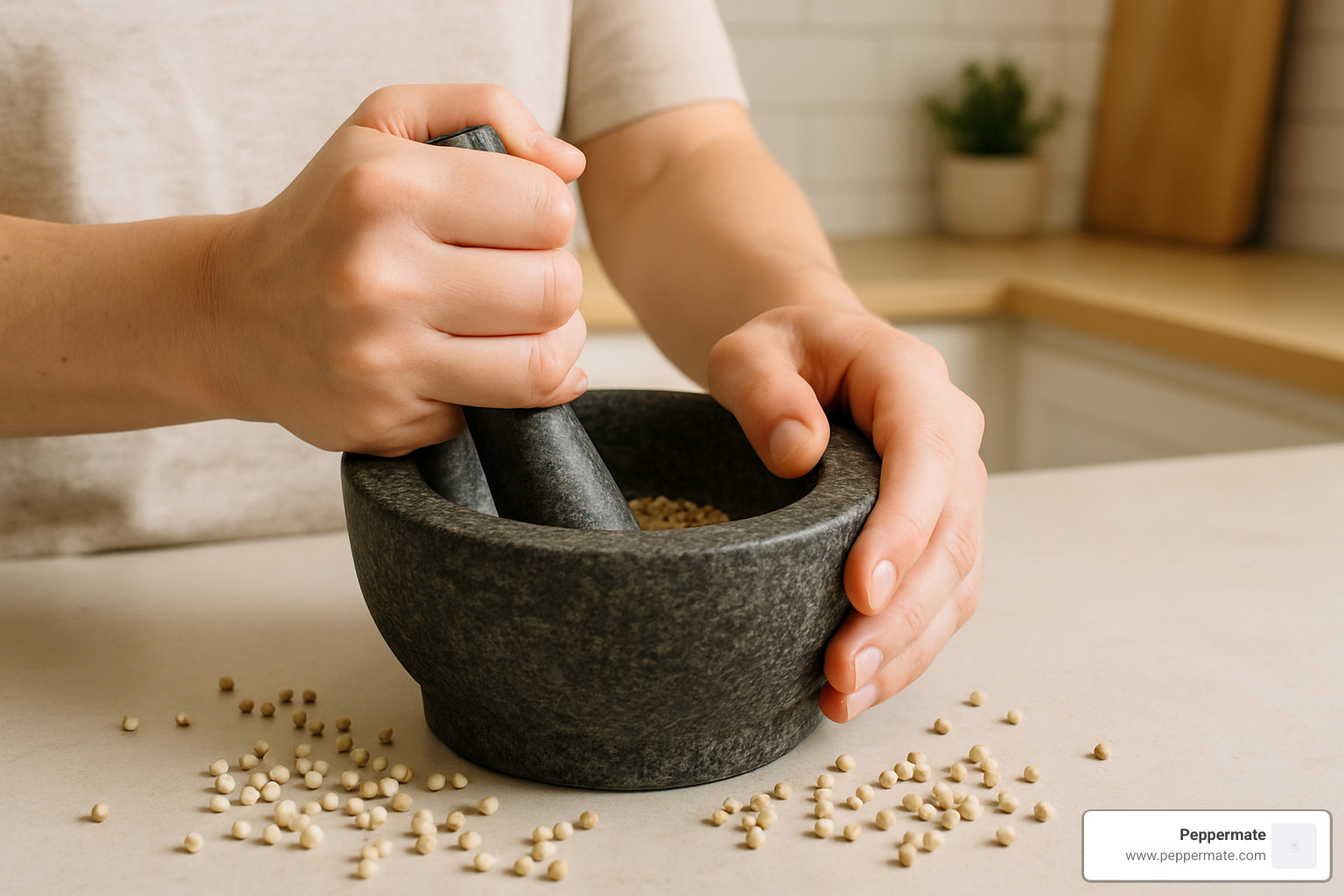
Method 4: Blender for Big Batches
When you need serious quantities of ground white pepper - maybe you're making a large batch of spice blend or prepping for a dinner party - your regular kitchen blender becomes surprisingly effective.
The blender approach requires at least 1/4 cup of peppercorns to create enough movement for effective grinding. Pulse in short bursts rather than running continuously, and shake the blender between pulses to redistribute the peppercorns. This prevents some from getting stuck at the bottom while others bounce around the top.
Continue pulsing until you reach your desired consistency, then store immediately in airtight containers. Freshly ground pepper from blender grinding stays potent for about five days when stored properly, making it perfect for meal prep or when you're cooking for crowds.
Dial-In Grind Size & Use It Right
The magic of how to grind white peppercorn lies in matching the right grind size to your dish. Too fine and you'll overpower delicate flavors. Too coarse and you'll get uneven heat distribution that can make someone bite down on a pepper bomb.
Think of grind size like salt - you wouldn't use coarse sea salt the same way you'd use table salt. White pepper works the same way, and getting this right separates good cooks from great ones.
Fine powder dissolves almost instantly, making it perfect for soups, cream sauces, and mashed potatoes where you want heat without texture. Medium grind gives you the best of both worlds - it integrates well but still provides little flavor bursts. This is your go-to for seasoning proteins before cooking, mixing into spice rubs, or adding to marinades. Coarse or cracked pepper delivers intense flavor bombs that hit your palate in waves. Save this for finishing touches on dishes where you want people to know there's white pepper involved.
The secret weapon here is sifting your freshly ground pepper through a fine mesh. This separates the different particle sizes and gives you options from one grinding session. Don't throw away those coarser pieces that don't make it through the sieve - they're perfect for marinades where you want maximum flavor impact.
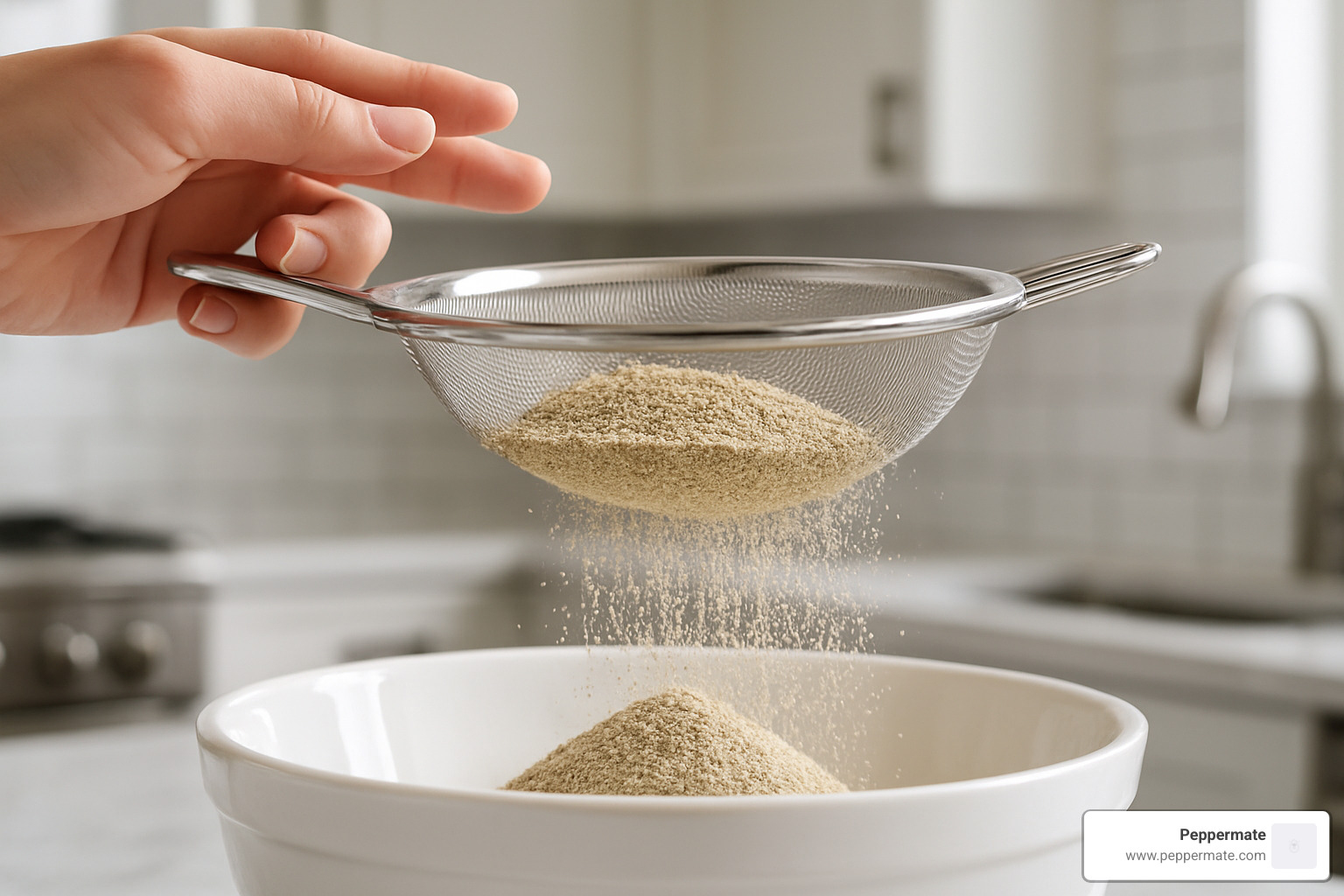
Quick Reference Grind Chart
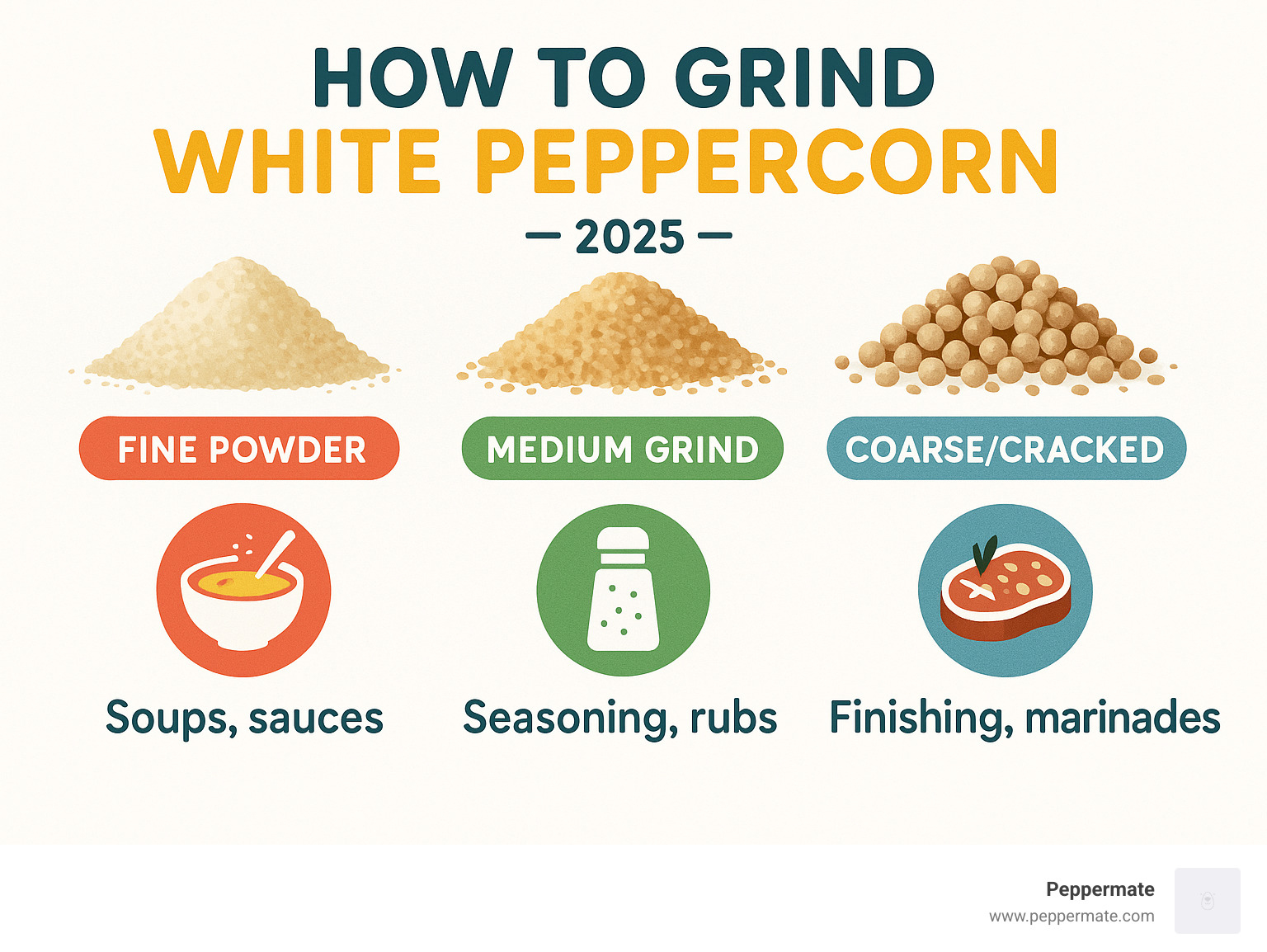
Storing Freshly Ground Pepper
Here's the hard truth about ground spices: they're living on borrowed time from the moment you grind them. While whole white peppercorns can sit in your pantry for years, ground pepper starts losing its punch after about three months.
The enemies are simple: air, light, and heat. Every time you open that container, precious essential oils escape into your kitchen instead of into your food.
Glass containers with tight-fitting lids are your best friends here. Plastic containers absorb odors and don't seal as well, while those little spice shaker bottles from the store are practically designed to let air in. Invest in small glass jars - smaller means less air space and better preservation.
Keep your containers in a cool, dark spot away from your stove and dishwasher. That spice rack above your cooktop might look convenient, but it's basically a sauna for your spices.
Here's the habit that will change your spice game: date everything. Write the grinding date on masking tape and stick it to your container. After three months, even the best-stored ground white pepper develops stale, dusty flavors that won't improve your cooking.
The In-Depth Guide to Flavor explains why fresh grinding makes such a dramatic difference - those volatile oils that create aroma and complex heat are incredibly fragile once exposed to air.
Troubleshooting & Common Pitfalls
Learning how to grind white peppercorn perfectly takes practice, and even experienced cooks hit bumps along the way. Don't worry - most pepper grinding mishaps are fixable with a few simple adjustments.
Over-roasting is probably the most heartbreaking mistake. You'll know it happened when your kitchen fills with acrid smoke and your peppercorns turn dark brown or black. Unfortunately, there's no saving burned pepper - it'll taste bitter and ruin any dish you add it to. The fix? Start over with fresh peppercorns and keep that heat low. We're gently warming the essential oils, not making charcoal.
Grinder clogging usually catches people off guard right when they're in the middle of cooking. This happens when you grind peppercorns that weren't completely cool from toasting, or when moisture gets into the mechanism. The oils and steam create a paste that jams everything up. Clean your grinder thoroughly with the rice method, then make sure your peppercorns are bone-dry and room temperature before your next grinding session.
Nothing's more frustrating than uneven grinding - you end up with powder mixed with whole peppercorns that crack between your teeth. This usually means you're overfilling your grinder or your equipment needs attention. Try grinding smaller batches, and check if your pepper mill's ceramic burrs need adjustment or replacement.
Cross-contamination sneaks up on you. One day your white pepper tastes like last week's cumin, and you realize you forgot to clean between spices. That rice cleaning hack I mentioned earlier? It's your best friend for preventing these muddy flavors that make everything taste like mystery spice blend.
Forgetting to sift might seem like a small step, but those gritty bits will remind you why it matters. Nobody wants to bite down on a chunk of hard pepper while enjoying a smooth soup. Keep that fine-mesh sieve handy - it's the difference between professional-quality seasoning and amateur hour.
Moisture absorption turns your beautiful ground pepper into clumpy, flavorless dust. Ground pepper acts like a sponge for humidity, which is why proper storage matters so much. Those airtight containers aren't just suggestions - they're essential for maintaining the heat and aroma you worked so hard to preserve.
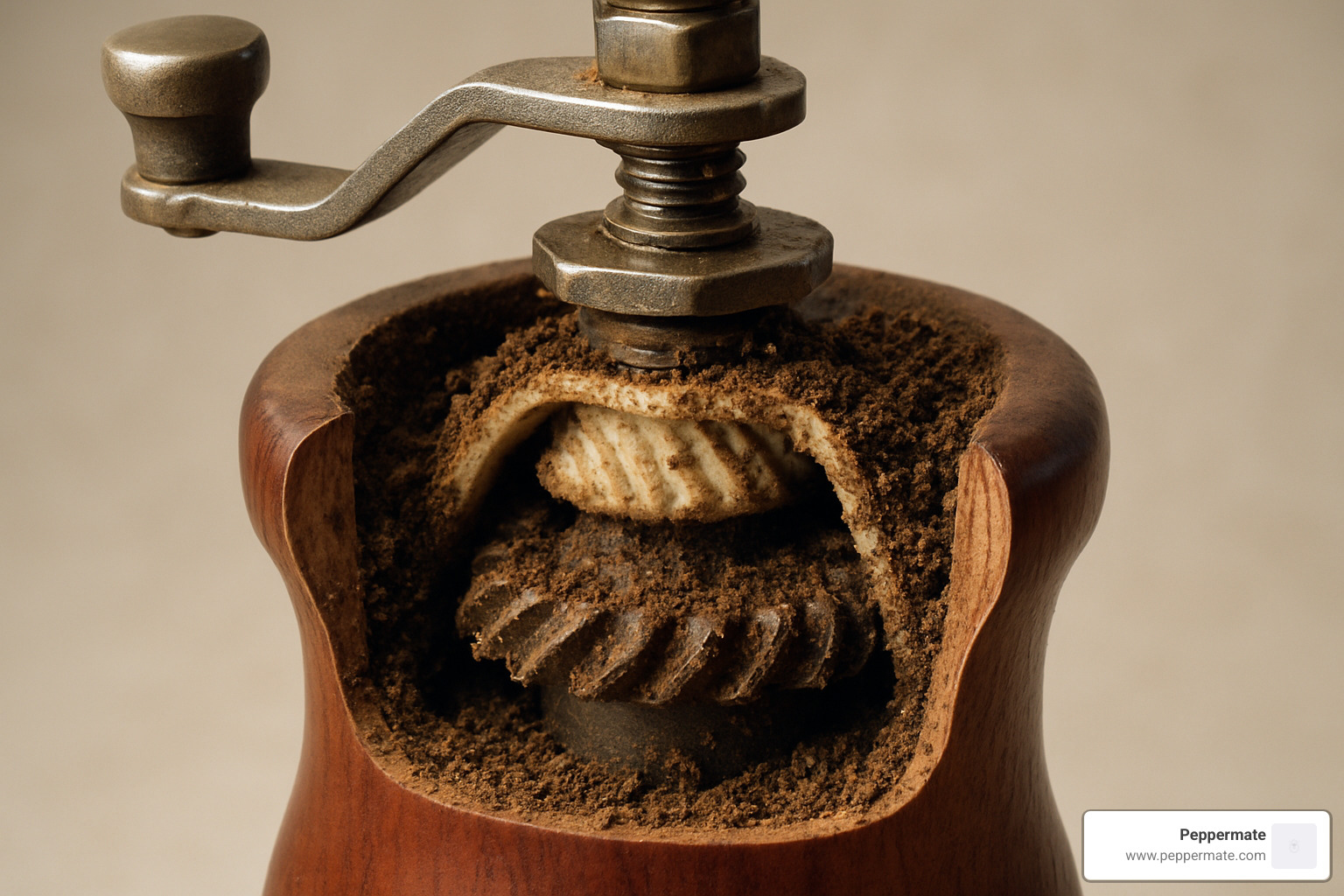
The good news? Most of these problems are preventable once you know what to watch for. Keep your equipment clean, your peppercorns dry, and your heat gentle. With a quality grinder and proper technique, you'll be grinding perfect white pepper every time.
Frequently Asked Questions about Grinding White Peppercorns
Why grind white pepper yourself instead of buying pre-ground?
The difference between freshly ground and pre-ground white pepper is like comparing a fresh tomato to one that's been sitting on the shelf for months. Pre-ground pepper loses its punch fast - those precious essential oils that give white pepper its distinctive heat and aroma start escaping the moment the peppercorn is broken open.
Commercial pre-ground pepper has several problems. It often sits in warehouses and on store shelves for months before reaching your kitchen. By then, much of the volatile flavor compounds have already disappeared. You're left with dusty, muted heat instead of the sharp, clean fire that makes white pepper special.
Many commercial brands also add anti-caking agents to prevent clumping. While these additives are safe, they can affect the pure flavor you're looking for. Some cheaper brands even mix in fillers to stretch the product further.
When you grind white peppercorn yourself, you control everything. You know exactly what's going into your food, and you get maximum flavor impact. The difference is so dramatic that most cooks never go back to pre-ground once they try fresh.
Can I use the same grinder for black and white pepper?
Absolutely! You don't need separate grinders for different types of pepper, though you do need to clean between uses if you want to taste the distinct characteristics of each variety.
The rice cleaning trick works perfectly for this. Just run a handful of uncooked white rice through your grinder, brush out the resulting rice flour, and wipe the chamber clean. This removes the residual oils that carry flavor from one pepper to the next.
For everyday cooking, one quality grinder handles both black and white pepper beautifully. The flavors are complementary enough that a tiny bit of crossover won't hurt most dishes. However, if you're working with expensive single-origin peppers where subtle flavor differences matter, you might want to be extra thorough with cleaning.
Some passionate cooks do keep separate grinders, but it's more about preference than necessity. A good ceramic burr grinder with proper maintenance serves all your pepper needs.
How long does freshly ground white pepper stay flavorful?
Freshly ground white pepper is like fresh herbs - amazing at first, but it doesn't last forever. You'll get peak flavor for about three months when stored properly in airtight containers away from light and heat.
After that three-month mark, the essential oils start breaking down noticeably. The pepper doesn't go bad, but it loses that sharp, clean heat that makes white pepper worth using. It becomes more like a mild warming spice instead of the flavor powerhouse it should be.
For the absolute best results, grind only what you'll use within two weeks. The difference between week-old and month-old ground pepper is significant enough that you'll taste it in your cooking. This is why having a good pepper mill makes such a difference - you can grind small amounts as needed.
The good news is that whole white peppercorns keep their quality for 2-3 years when stored properly. This makes it smart to buy larger quantities of whole peppercorns and grind them fresh rather than buying small amounts of pre-ground pepper that's already losing flavor.
Conclusion
You've just open uped the secret to how to grind white peppercorn like a pro. The journey from whole peppercorns to aromatic powder might seem simple, but as you've finded, proper technique makes all the difference between bland seasoning and flavor that truly transforms your cooking.
Think about it - that clean, sharp heat that lifts your cream soups without leaving black specks. The fermented funk that makes your stir-fries taste like they came from your favorite restaurant. The precise control over grind size that lets you dial in exactly the right texture for each dish. This is what fresh grinding delivers every single time.
Your grinding success formula is straightforward: toast those peppercorns first to wake up their essential oils, cool them completely to prevent clumping, choose the right tool for your batch size, sift out any gritty bits, and store everything properly to keep that potency alive for months.
Whether you're twisting away with one of our lifetime-warranty ceramic grinders or getting traditional with a mortar and pestle, the magic happens when you release those oils right when you need them. Pre-ground pepper sitting in your spice rack for months just can't compete with that fresh aromatic punch.
More info about choosing mills can help you find the perfect grinding companion for your cooking style. Our patented side handle design and clear base make it easy to see exactly what you're working with.
Don't be shy about experimenting with different regional varieties either. Sarawak's balanced complexity, Muntok's clean heat, Penja's citrusy notes - each brings something unique to your kitchen. Try different grind sizes too. Fine powder for soups, medium for general seasoning, coarse cracks for finishing touches.
The beauty of white pepper lies in its versatility. That clean heat profile works everywhere from delicate fish preparations to robust marinades. Once you start grinding fresh, you'll notice how much more control you have over your seasoning.
Spice Up Your Life With These White Peppercorn Grinders and find how the right equipment transforms your grinding game completely.
Cooking is about building layers of flavor. Freshly ground white pepper gives you a tool that's both subtle and powerful. Start small, taste as you go, and let your palate guide you toward that perfect grind for each dish.
Your journey into how to grind white peppercorn properly starts now. Every twist of the mill, every pulse of the grinder, every pound of the pestle brings you closer to flavors that will make your family and friends wonder what your secret ingredient is.
Happy grinding, and may your white pepper always be fresh, aromatic, and perfectly ground!



